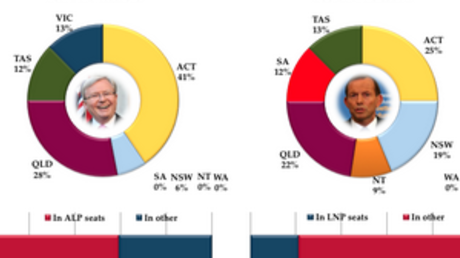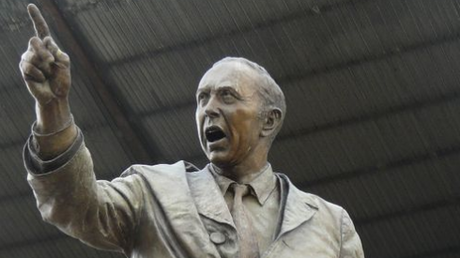THE UNOFFICIAL election campaign increased in intensity today, with the Liberal Party releasing two new ads – one positive (above) and one negative (below) – as part of an advertising blitz to counteract renewed media interest in Labor’s Kevin Rudd.
 The choice to ditch earlier ads featuring personal attacks on Mr Rudd by Labor Party colleagues in favour of these new ads are an apparent response to Mr Rudd’s public pitch last week for positivity, saying Australians were “sick and tired of negative politics” and personal attacks. (See our analysis here.)
The choice to ditch earlier ads featuring personal attacks on Mr Rudd by Labor Party colleagues in favour of these new ads are an apparent response to Mr Rudd’s public pitch last week for positivity, saying Australians were “sick and tired of negative politics” and personal attacks. (See our analysis here.)
This is probably the right strategy, but it demonstrates once again that Mr Rudd is setting the terms of public debate. The Coalition is playing defense.
Both of the Liberal Party’s new ads emulates the ‘dot point rhetoric’ of Mr Rudd’s ad offering last week, and his address to the National Press Club on Thursday. In the positive ad, Opposition Leader Tony Abbott sits at a desk in front of a large Australian flag and large collection of leather bound books from where he outlines their plan for the country.
Their campaign manifesto “Our Plan: Real Solutions for All Australians” appears at the foot of the screen as he enumerates its key features:
- 2 million new jobs over 10 years,
- A ‘five pillar economy’ building on our agriculture,
- Mining and manufacturing industries,
- Lower taxes,
- Lower debt and stronger boarders.
The ad closes with an off-camera female voice advising viewers they can download the full document from www.realsolutions.org.au
The negative ad is twice as long – a full minute. It’s narrated by an off-camera growling, even menacing male voice accompanied by somber music and dark, still images of Mr Rudd overlaid with rolling statements on his previous record as prime minister.
These nine statements include;
- [Wasting] up to $8 billion on school hall rip-offs,
- Increased government debt,
- Dismantling our border protection policies’ resulting in "45,000 boat people [flooding] in",
- Internal Labor Party divisions and the carbon tax.
The ad concludes by stating, perhaps contradictorily given the scrolling list of activities, that Kevin Rudd is all talk and asks viewers to imagine three more years of Labor failure.
It is an interesting choice of content, perhaps trying span the divergent electoral concerns in different states. For instance, “Stopping the boats” might resonate in parts of Queensland and New South Wales but doesn’t play as well in Victoria where Liberal campaign materials tend to avoid the issue. Similarly, constructing or renovating buildings in each of Australia’s 10,000 odd schools was welcomed by much of the electorate. Many will also recall that this scheme, rushed into implementation along with Pink Batts, was part of the urgent fiscal stimulus package that is credited with helping Australia weather the global financial crisis. Cabinet divisions are fresh in everyone’s mind, and barely a week passes without news of more asylum seekers attempting the dangerous trip to our shores, sometimes resulting in horrific and fatal tragedies.
Like all political ads, most telling is what is left unsaid. No new spending on schools, health or the environment, no pledge to cut income or business taxes, no promises to quickly return the budget to surplus, and no detail on how these policy goals will be achieved. Some of this information is in their manifesto online.
Taken together, however, these two ads seem a strong defense to a resurgent Labor Party in the polls, reminding voters of Mr Rudd’s most divisive actions and targeting Labor’s greatest electoral concerns.
UPDATE —
THE ATTACK ad released yesterday by the Liberal Party claims as a "fact" that the Rudd government wasted "up $8 billion" on "school hall rip-offs". The total cost of Building the Education Revolution program was $16.2billion, suggesting the Coalition believes half the buildings were built wastefully.
This claim completely contradicted by the Orgill Taskforce which reported in July 2011. It found the overwhelming majority of BER projects were delivered within budget and time constraints.
Or perhaps the Liberal Party are suggesting that up to half of Australia's schools shouldn't have received new infrastructure? This too is at odds with the contents of the report, which cites principals emphasisng their appreciation for the BER program which they believed would improve educational outcomes.
Independent public schools?
On a related note, a minor storm flared on twitter last night, with some prominent public school advocates claiming the Liberal Party want to privatise public schools, pointing to this paragraph (seen below) in their policy manifesto. This is not the case, although the language is definitely confusing.
The Coalition proposes to assist public schools become "independent schools". This phrase is understandably controversial. But the Coalition seems talking about a model that exists in Western Australia and a lesser extent in Victoria, where public schools are given much more independence: that is, public schools will not be converted to private schools, but converted to more independent public schools.
 In other words, they are proposing increased autonomy for public schools - with the school and states' permission. It does not mean privatising them, as they would continue to receive full government funding. They NOT at all same as "independent" schools, the subsection of non-government schools that do not belong to a system (such as Catholic system).
In other words, they are proposing increased autonomy for public schools - with the school and states' permission. It does not mean privatising them, as they would continue to receive full government funding. They NOT at all same as "independent" schools, the subsection of non-government schools that do not belong to a system (such as Catholic system).
These "independent" schools are usually selective, charge fees, and are the most well-resourced of all private schools. And while Twitter excitement may have given the impression this was a recent announcement, the Liberal Party's "independent public schools" policy idea was floated in their "Our Solution" campaign document back in January.
(For more information on Western Australia's public schools, read this report by Melbourne's Graduate School of Education.)
Finally, while contentious, state governments have been increasing schools' autonomy in inches and waves since the 1970s. Indeed, increased powers for schools over their budgets, staffing decisions and other aspects was a recommendation of the Karmel Report commissioned by the Labor Whitlam government! It was also a recommendation of the Gonski Report and to varying degrees is already part of the reform agenda of the federal Labor government, and most Labor and Liberal states.
Admittedly, voters can be forgiven for this misunderstanding given the lack of detail and clumsy wording in the Liberal Party manifesto. Sadly, the Greens education policy as described in their election manifesto, also released yesterday is extremely short on detail but big on aspirations. I sincerely hope more detail - clear detail - is released before the election to allow voters an informed choice on this critically important policy area.




